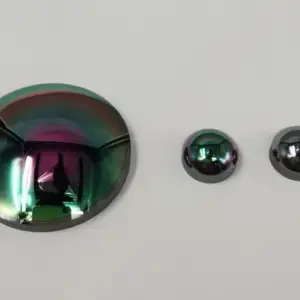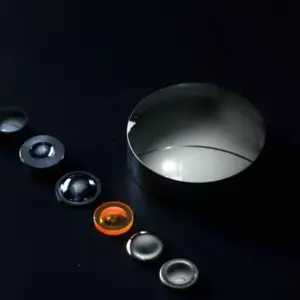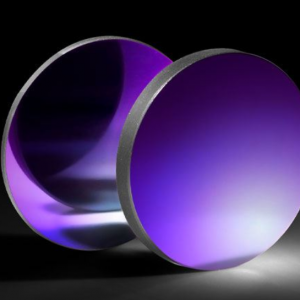Description
Introduction
Chalcogenide materials, comprising elements like sulfur (S), selenium (Se), and tellurium (Te), are renowned for their exceptional infrared (IR) transmission and unique optical properties. Shape Optics specializes in the production of molded chalcogenide aspheres, providing advanced optical solutions tailored to meet specific industry requirements.
Properties and Uses in Infrared Optics
Molded chalcogenide aspheres are ideal for mid-IR optics due to their wide transmission range from 0.5 μm to 25 μm, low refractive index temperature coefficient (dN/dT), and low dispersion. These lenses are extensively used in thermal imaging, IR spectroscopy, and laser systems. Compared to traditional IR materials like Germanium (Ge) and Zinc Selenide (ZnSe), chalcogenides offer higher production efficiency and lower costs, reducing the consumption of scarce resources like Ge.
General Specifications
- Composition: Varies by grade (e.g., Ge33_{33}As12_{12}Se55_{55}, Ge22_{22}As20_{20}Se58_{58})
- Density: 3.2 to 4.84 g/cm³
- Diameter: 1-25 mm
- Diameter Tolerance: Standard ±0.015 mm, Precision ±0.005 mm
- Thickness Tolerance: Standard 0.03 mm, Precision 0.005 mm
- Irregularity (P-V): Standard <1 μm, Precision <0.6 μm
- Irregularity (RMS): Standard 0.3 μm, Precision 0.08 – 0.15 μm
- Centering Error: 1′
- Surface Quality: Standard 60-40, Precision 20-10
Physical Properties
Chalcogenide glasses have higher densities compared to traditional optical glasses, enhancing their robustness. Their moderate thermal expansion coefficients ensure compatibility with various substrates and reduce thermal stress. These materials’ high transition temperatures indicate good thermal stability, making them suitable for high-temperature applications.
Mechanical Properties
Chalcogenide glasses possess moderate hardness, making them easier to process and mold compared to harder materials like Ge and ZnSe. Precision molding technology allows these materials to be formed into flat, spherical, and aspherical lenses, enhancing their versatility. However, they are more prone to scratching, necessitating careful handling.
Chemical Properties
Chalcogenide glasses are chemically stable and resistant to water and most acids, ensuring durability in harsh environments. Their unique composition minimizes reactions with environmental elements, enhancing longevity. These properties make them suitable for applications where exposure to harsh chemicals is expected.
Optical Properties
Chalcogenide lenses offer excellent IR transmission, covering wavelengths from 0.5 μm to 25 μm. Their low dispersion and high refractive indices are beneficial for designing high-performance IR optics. These properties make them ideal for applications requiring precise light control, such as IR spectroscopy and thermal imaging.
Transmission Wavelength
The broad transmission range of chalcogenide lenses ensures their suitability for various IR applications. Their ability to transmit wavelengths from 0.5 μm to 25 μm allows them to be used in diverse fields such as defense, medical imaging, and environmental monitoring. This extensive range provides versatility in designing optical systems for a wide array of applications.
Table of Chalcogenide Compositions
| Grade | Composition | Density (g/cm³) |
|---|---|---|
| WIRG01 | Ge33_{33}As12_{12}Se55_{55} | 4.42 |
| WIRG02 | Ge22_{22}As20_{20}Se58_{58} | 4.41 |
| WIRG03 | Ge20_{20}Sb15_{15}Se65_{65} | 4.71 |
| WIRG04 | As30_{30}Sb4_{4}Se63_{63}Sn3_{3} | 4.72 |
| WIRG05 | Ge28_{28}Sb12_{12}Se60_{60} | 4.68 |
| WIRG06 | As40_{40}Se60_{60} | 4.63 |
| WIRG07 | Ge10_{10}As40_{40}Se50_{50} | 4.49 |
| WIRG08 | As40_{40}Se60_{60} | 3.2 |
| WIRG09 | Ge30_{30}As13_{13}Se32_{32}Te25_{25} | 4.84 |
Specifications for Chalcogenide Lens Manufacturing
| Specifications | Standard | Precision |
|---|---|---|
| Diameter | 1-25 mm | 1-25 mm |
| Diameter Tolerance | ±0.015 mm | ±0.005 mm |
| Thickness Tolerance | 0.03 mm | 0.005 mm |
| Irregularity (P-V) | <1 μm | <0.6 μm |
| Irregularity (RMS) | 0.3 μm | 0.08 – 0.15 μm |
| Centering Error | 1′ | 1′ |
| Surface Quality | 60-40 | 20-10 |
Material Properties of Chalcogenide Glass
| Sr. No. | Glass | IRG 22 | IRG 24 | IRG 25 | IRG 26 | IRG 27 |
|---|---|---|---|---|---|---|
| 1 | Composition | Ge33_{33}As12_{12}Se55_{55} | Ge40_{40}As4_{4}Se56_{56} | Ge28_{28}Sb12_{12}Se60_{60} | As40_{40}Se60_{60} | As40_{40}S60_{60} |
| 2 | Density | 4.41 g/cm³ | 4.47 g/cm³ | 4.66 g/cm³ | 4.63 g/cm³ | 3.20 g/cm³ |
| 3 | Thermal Expansion (20-100 °C) | 12.5 × 10−6^{-6}/K | 20.0 × 10−6^{-6}/K | 14.0 × 10−6^{-6}/K | 21.4 × 10−6^{-6}/K | 22.5 × 10−6^{-6}/K |
| 4 | Transition Temperature | 368 °C | 225 °C | 285 °C | 185 °C | 197 °C |
| 5 | Thermal Change dN/dT | 94.8 × 10−6^{-6}/K (1 μm) | 46.0 × 10−6^{-6}/K (1 μm) | 79.2 × 10−6^{-6}/K (1 μm) | 76.2 × 10−6^{-6}/K (1 μm) | 15.6 × 10−6^{-6}/K (1 μm) |
| 67.7 × 10−6^{-6}/K (5 μm) | 21.1 × 10−6^{-6}/K (5 μm) | 62.0 × 10−6^{-6}/K (5 μm) | 33.4 × 10−6^{-6}/K (5 μm) | -3.2 × 10−6^{-6}/K (5 μm) | ||
| 67.1 × 10−6^{-6}/K (10 μm) | 20.3 × 10−6^{-6}/K (10 μm) | 61.1 × 10−6^{-6}/K (10.6 μm) | 32.2 × 10−6^{-6}/K (10.6 μm) | -3.7 × 10−6^{-6}/K (10.6 μm) | ||
| 6 | Refractive Index | 2.5971 (1 μm) | 2.7249 (1 μm) | 2.7284 (1 μm) | 2.9316 (1 μm) | 2.4841 (1 μm) |
| 2### Molded Chalcogenide Aspheres for Infrared Optics |













Reviews
There are no reviews yet.